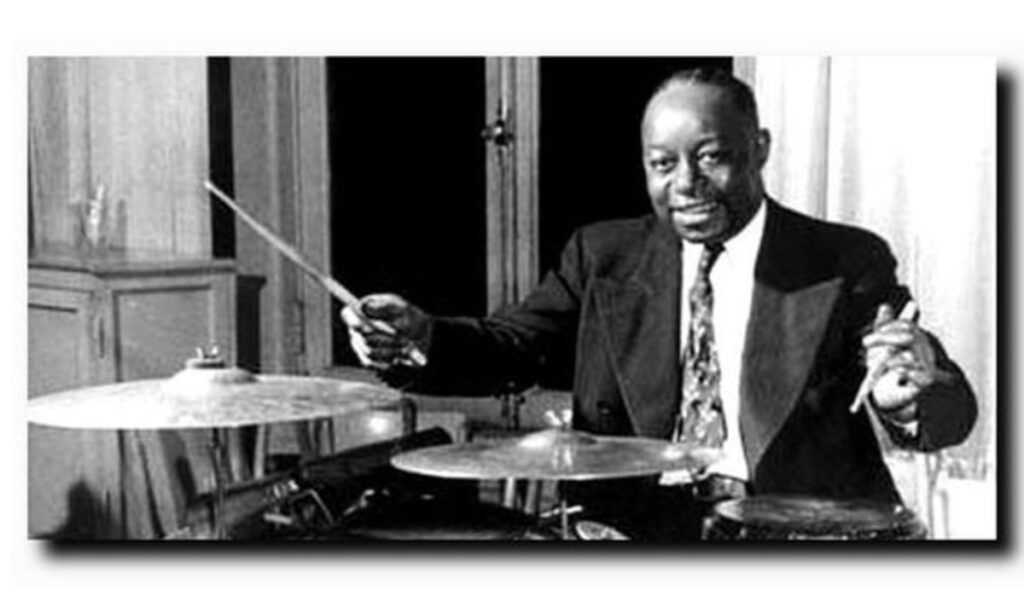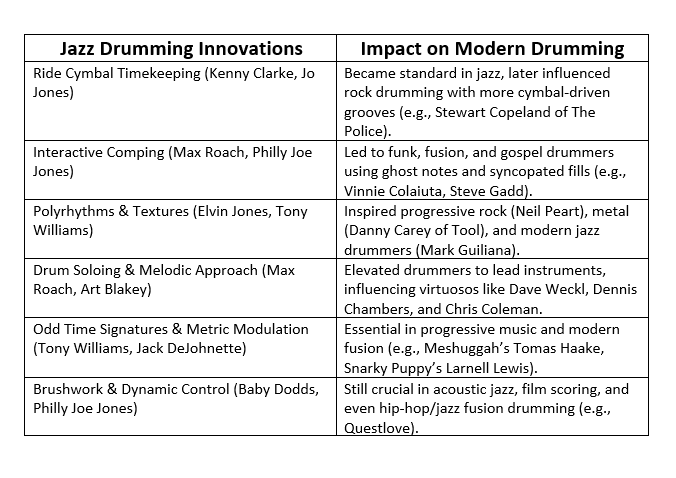Drums
From Bebop to Modern Beats: The Influence of Jazz Drumming

The evolution of jazz drumming, particularly with the rise of bebop in the 1940s, forever changed the way drums are played. What began as simple timekeeping in early jazz transformed into a dynamic, interactive, and highly expressive art form. Pioneers like Kenny Clarke, Max Roach, and Elvin Jones redefined the drummer’s role, introducing innovations that still shape modern drumming across multiple genres. Whether in jazz, rock, hip-hop, or electronic music, the fingerprints of these trailblazers remain evident in today’s most influential drummers.
The Evolution of Jazz Drumming
Early Jazz & Swing Era (1910s–1930s)
- Early jazz drummers like Baby Dodds (associated with Louis Armstrong’s Hot Five) played a rudimentary but swinging style using snare drum press rolls, woodblocks, and cymbals.
- The swing era saw drummers such as Gene Krupa (Benny Goodman’s orchestra) and Chick Webb develop more prominent, driving rhythms with powerful bass drum accents.
- Jo Jones (Count Basie Orchestra) pioneered using the hi-hat to maintain time instead of the bass drum, giving the rhythm a lighter, more fluid feel.
Bebop Revolution (1940s)
- Bebop shifted jazz from danceable big-band music to fast, intricate, and harmonically complex small-group improvisation.
- Drummers like Kenny Clarke revolutionized jazz drumming by shifting the timekeeping from the bass drum to the ride cymbal, allowing for more interactive and syncopated drum accompaniment.
- Max Roach expanded on this by introducing a more melodic and dynamic approach, treating the drum kit as a musical instrument rather than just a rhythm keeper.
Post-Bop & Hard Bop (1950s–1960s)
- Art Blakey, known for his work with the Jazz Messengers, introduced press rolls, polyrhythms, and intense dynamic shifts, making drums an integral part of jazz storytelling.
- Philly Joe Jones (Miles Davis Quintet) was known for his crisp, articulate playing and trading fours (exchanging solo phrases with other musicians).
- Elvin Jones (John Coltrane Quartet) introduced a more polyrhythmic and textural approach, making the drums flow more freely within the music.
Modern Jazz & Beyond (1970s–Present)
- Tony Williams (Miles Davis’ Second Quintet) brought a fusion of rock and jazz to the drum kit, playing with incredible speed and aggression.
- Jack DeJohnette blended swing, free jazz, and rock elements, influencing many modern drummers.
- Brian Blade and Marcus Gilmore continue pushing jazz drumming forward with their intricate phrasing and dynamic control.
The Key Drummers in the Evolution of Jazz and Bebop
These drummers contributed to jazz drumming’s development, making it more expressive, interactive, and dynamic. Bebop, in particular, pushed drummers to be more than timekeepers, they became improvisers and equal musical partners in the ensemble.
- Baby Dodds – Early jazz innovator, foundational swing beats.
- Chick Webb – Virtuosic swing drummer, influenced Gene Krupa.
- Gene Krupa – Popularized drum solos and tom-tom use.
- Jo Jones – Moved timekeeping to the hi-hat, freeing up the bass drum.
- Kenny Clarke – Shifted time to the ride cymbal, a bebop pioneer.
- Max Roach – Innovator in bebop drumming, used the kit melodically.
- Art Blakey – Known for explosive, thunderous hard bop playing.
- Philly Joe Jones – Perfected bebop comping and trading fours.
- Elvin Jones – Pioneered polyrhythmic, rolling drum textures.
- Tony Williams – Revolutionized jazz drumming with fusion.
Impact of Jazz Drumming on Modern Drumming
-
The Ride Cymbal as the Primary Timekeeper
- Bebop revolutionized timekeeping by shifting the pulse from the bass drum to the ride cymbal, a concept pioneered by Kenny Clarke and later refined by Max Roach.
- This approach gave drummers more freedom to interact with soloists and shaped modern jazz drumming. Today, drummers like Brian Blade and Marcus Gilmore continue to expand on this expressive ride cymbal technique.
-
Drumming as a Conversation
- Bebop drummers transformed drumming from static timekeeping into a conversational art form, responding to other musicians dynamically.
- This interactive style influences modern drummers like Chris Dave (who blends jazz phrasing with hip-hop) and Nate Smith (who fuses jazz spontaneity with funk grooves).
-
Polyrhythms & Complex Time Signatures
- Elvin Jones introduced rolling triplet-based phrasing, while Tony Williams pushed jazz into high-energy fusion, paving the way for complex rhythmic structures.
- Their influence is clear in drummers like Matt Garstka (Animals as Leaders), Danny Carey (Tool), and Vinnie Colaiuta (Frank Zappa, Sting), who incorporate jazz-inspired polyrhythms into progressive rock and fusion.
-
The Drum Kit as a Melodic Instrument
- Max Roach pioneered the idea of treating drums as a melodic voice rather than just a rhythmic tool.
- This legacy continues with drummers like Eric Harland and Ari Hoenig, who shape their drum solos like compositions, making the kit a storytelling instrument.
-
Jazz Drumming’s Influence on Other Genres
- Jazz drumming innovations have influenced everything from rock (John Bonham, Ginger Baker) to hip-hop (Questlove) and even electronic music (drum & bass breakbeats often mimic jazz drumming syncopation).
- Producers frequently sample jazz drummers like Clyde Stubblefield, bringing bebop-inspired rhythms into modern hip-hop and R&B.
Cross-Genre Influence
- Rock & Pop: Many rock drummers borrow jazz rudiments, comping, and dynamic control.
- Fusion & Funk: Drummers like Steve Gadd and Dave Weckl blend jazz phrasing with funk and groove.
- Hip-Hop & Electronic: Jazz drumming’s swing feel and breakbeats influenced drummers like Questlove and even drum programming in electronic music.
- Progressive & Metal: Bebop’s complex phrasing and polyrhythms inspired drummers like Danny Carey (Tool) and Matt Garstka (Animals as Leaders).
In short, jazz drumming—especially bebop—set the foundation for modern drumming’s creativity, expressiveness, and technical evolution.
Here are some notable drum solos from jazz and beyond that showcase the evolution and impact of jazz drumming:
Classic Bebop & Hard Bop Solos
- Max Roach – “The Drum Also Waltzes” (Solo Performance)
-
- A masterpiece in melodic drumming, demonstrating how a drum kit can sing without accompaniment.
- Art Blakey – “A Night in Tunisia” (Live at Birdland, 1954)
-
- Explosive rolls, thunderous press rolls, and call-and-response dynamics define hard bop drumming.
- Philly Joe Jones – “Salt Peanuts” (With Miles Davis, 1955)
-
- A perfect example of bebop drumming’s crisp articulation and interactive playing.
- Elvin Jones – “A Love Supreme, Pt. II – Resolution” (With John Coltrane, 1965)
-
- A showcase of Elvin’s legendary polyrhythmic approach, using triplets to create a rolling, tidal wave effect.
Post-Bop & Fusion Era Solos
- Tony Williams – “7 Steps to Heaven” (With Miles Davis, 1963)
-
- At just 17 years old, Tony redefined jazz drumming with explosive energy and unpredictable phrasing.
- Jack DeJohnette – “Miles Runs the Voodoo Down” (With Miles Davis, 1970)
-
- A fusion classic that blends swing with rock aggression, showing early jazz-fusion drumming’s power.
- Billy Cobham – “Stratus” (Spectrum, 1973)
-
- A fusion drumming milestone, featuring lightning-fast fills and heavy grooves that influenced rock drummers.
Modern Drumming Inspired by Jazz
- Vinnie Colaiuta – “Sting’s Bring on the Night” (Live, 1991)
-
- A stunning display of jazz-fusion drumming with incredible speed, fluidity, and dynamic control.
- Chris Dave – “Again” (D’Angelo & The Vanguard, 2014)
-
- A jazz-infused hip-hop groove full of micro-timing, ghost notes, and broken beats.
- Mark Guiliana – “Taming the Dragon” (With Brad Mehldau, 2014)
-
- A modern blend of electronic beats, jazz phrasing, and improvisational freedom.
Each of these drum solos represents a different evolutionary stage in jazz drumming, showing how its influence continues across styles.
The revolutionary ideas introduced by bebop and jazz drummers continue to shape every aspect of modern drumming. From ride cymbal phrasing to polyrhythms, from melodic drumming to cross-genre experimentation, their impact is undeniable. Whether in a jazz club, a rock arena, or a hip-hop studio, the echoes of bebop’s rhythmic innovations are alive and well, inspiring new generations of drummers to push the boundaries even further.


